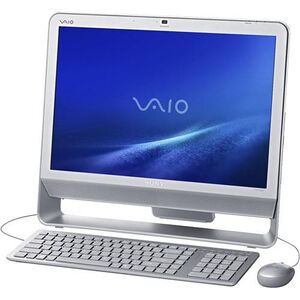VGC-JS: Difference between revisions
More actions
No edit summary |
No edit summary |
||
| Line 2: | Line 2: | ||
==Overview== | ==Overview== | ||
[[File:VGC-JS.jpg|alt=VGC-JS|thumb|VGC-JS]] | [[File:VGC-JS.jpg|alt=VGC-JS|thumb|VGC-JS]] | ||
The Sony VAIO VGC-JS was a low-mid end desktop All-In-One released by Sony in 2008. It was meant for people who people who didn't want to clutter up their desk with a desktop PC, but wanted more screen size than a laptop. It was praised by reviewers for looking "attractive" and having relatively good performance for its price. In the UK it was possible to get one for a sub-£640 price-tag. For that, one got a 20.1in display with the usual 1,680 x 1,050 resolution, with decent specifications including a 2.53GHz Core 2 Duo, 500GB hard drive, 3GB of RAM and Intel GMA X4500HD graphics (VGC-JS1E). Most models came with a DVD-RW drive, but some later and higher end ones came with BluRay drives. It was powered by a typical Sony 19.5V power adapter, due to it not having space for a PSU inside. | The Sony VAIO VGC-JS was a low-mid end desktop All-In-One released by Sony in 2008. It was meant for people who people who didn't want to clutter up their desk with a desktop PC, but wanted more screen size than a laptop. It was praised by reviewers for looking "attractive" and having relatively good performance for its price. In the UK it was possible to get one for a sub-£640 price-tag. For that, one got a 20.1in display with the usual 1,680 x 1,050 resolution, with decent specifications including a 2.53GHz desktop-class Core 2 Duo, 500GB hard drive, 3GB of RAM and Intel GMA X4500HD graphics (VGC-JS1E). Most models came with a DVD-RW drive, but some later and higher end ones came with BluRay drives and an NVIDIA 9300M GS graphics card. It was powered by a typical Sony 19.5V power adapter, due to it not having space for a PSU inside. | ||
==Detailed Specs== | ==Detailed Specs== | ||
'''Processor:''' Intel Core 2 Duo | '''Processor:''' Intel Core 2 Duo or Intel Pentium (LGA 775) | ||
'''Graphics:''' Intel GMA X4500HD | '''Graphics:''' Intel GMA X4500HD or NVIDIA 9300M GS | ||
'''Chipset:''' Intel | '''Chipset:''' Intel P43 Express | ||
'''Memory:''' 2GB (Standard), 8GB (Maximum) | '''Memory:''' 2GB or 4GB DDR2 (Standard), 8GB (Maximum) | ||
'''Display:''' 20.1" TN LCD 1680×1050 | '''Display:''' 20.1" TN LCD 1680×1050 | ||
| Line 21: | Line 21: | ||
'''MSRP:''' roughly 700-1500 Euros | '''MSRP:''' roughly 700-1500 Euros | ||
==Daily Usage Today== | ==Daily Usage Today== | ||
This unit is definitely still usable today, as most units have decent Core 2 Duo processors. For office tasks like word documents and presentations it will definitely still be usable. Watching YouTube should work fine at 720p. We recommend installing an SSD, upgrading the RAM to 8GB and installing a lightweight Linux distribution such as AntiX. | This unit is definitely still usable today, as most units have decent Core 2 Duo processors. For office tasks like word documents and presentations it will definitely still be usable. Watching YouTube should work fine at 720p. We recommend installing an SSD, upgrading the RAM to 8GB and installing a lightweight Linux distribution such as AntiX or using an older Windows OS such as Windows 7. The optional 9300M GS is only capable of playing older games at low settings, but can play early 2000s games e.g Half Life with ease. | ||
==Resources== | ==Resources== | ||
| Line 28: | Line 28: | ||
[https://archive.org/details/vgc-js-4-eg VGC-JS Recovery Disks] | [https://archive.org/details/vgc-js-4-eg VGC-JS Recovery Disks] | ||
These recovery disks ARE model locked but CAN be bypassed with | These recovery disks ARE model locked but CAN be bypassed with our Recovery Patcher, SVRP, which can be found in the menu in the top left corner. | ||
==Credits== | ==Credits== | ||
Revision as of 12:09, 18 December 2023
This page is currently WIP!!
Overview

The Sony VAIO VGC-JS was a low-mid end desktop All-In-One released by Sony in 2008. It was meant for people who people who didn't want to clutter up their desk with a desktop PC, but wanted more screen size than a laptop. It was praised by reviewers for looking "attractive" and having relatively good performance for its price. In the UK it was possible to get one for a sub-£640 price-tag. For that, one got a 20.1in display with the usual 1,680 x 1,050 resolution, with decent specifications including a 2.53GHz desktop-class Core 2 Duo, 500GB hard drive, 3GB of RAM and Intel GMA X4500HD graphics (VGC-JS1E). Most models came with a DVD-RW drive, but some later and higher end ones came with BluRay drives and an NVIDIA 9300M GS graphics card. It was powered by a typical Sony 19.5V power adapter, due to it not having space for a PSU inside.
Detailed Specs
Processor: Intel Core 2 Duo or Intel Pentium (LGA 775)
Graphics: Intel GMA X4500HD or NVIDIA 9300M GS
Chipset: Intel P43 Express
Memory: 2GB or 4GB DDR2 (Standard), 8GB (Maximum)
Display: 20.1" TN LCD 1680×1050
Storage: 250-500GB HDD
Weight: 8.8kg
MSRP: roughly 700-1500 Euros
Daily Usage Today
This unit is definitely still usable today, as most units have decent Core 2 Duo processors. For office tasks like word documents and presentations it will definitely still be usable. Watching YouTube should work fine at 720p. We recommend installing an SSD, upgrading the RAM to 8GB and installing a lightweight Linux distribution such as AntiX or using an older Windows OS such as Windows 7. The optional 9300M GS is only capable of playing older games at low settings, but can play early 2000s games e.g Half Life with ease.
Resources
These recovery disks ARE model locked but CAN be bypassed with our Recovery Patcher, SVRP, which can be found in the menu in the top left corner.
